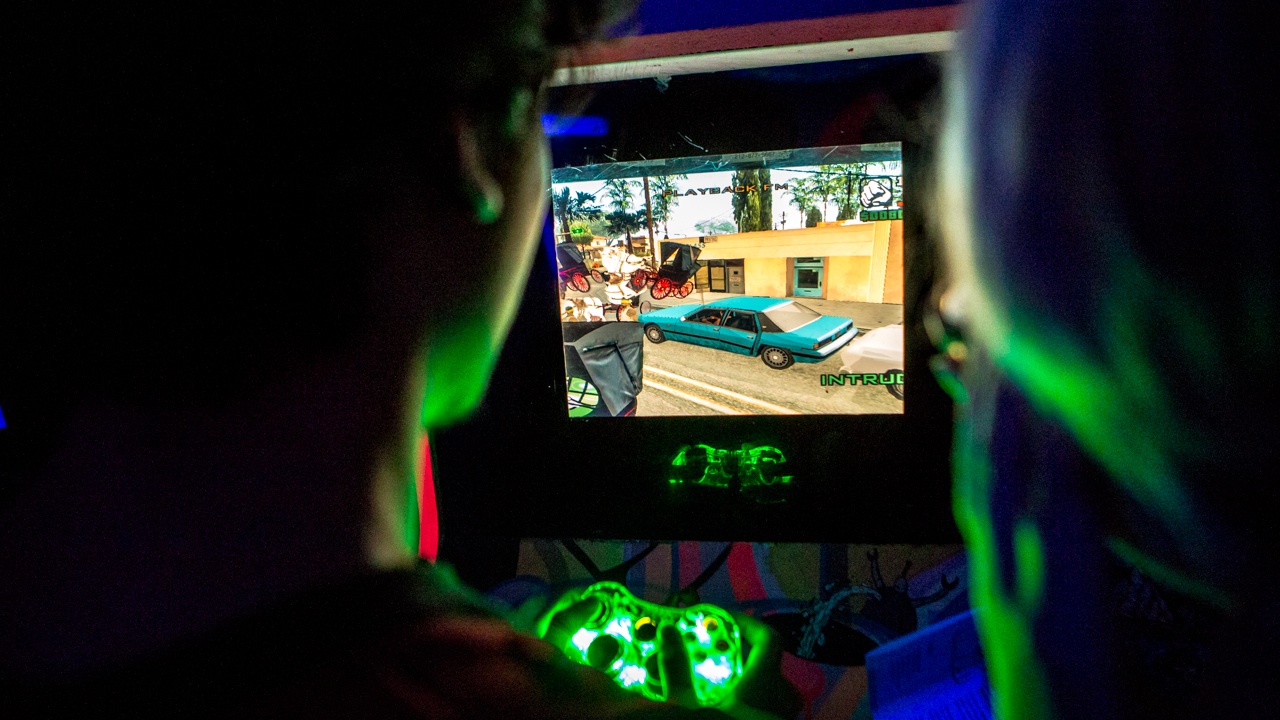One of my first experiences upon moving to New York was as a volunteer at the 42nd St. Showpaper Gallery. A few blocks from Grand Central Station and across from a ritzy hotel, it was a strange location for a venue that showcased experimental music and video games. It felt like I’d found my secret home, a crack in the monument to capitalism that is Manhattan.
The space housed work curated by the experimental video games collective Babycastles, ranging from a Christmas-themed sex game to a Super Mario mod that had players climbing the corporate ladder. It was a fitting introduction to the collective, which makes art at its most joyous and populist, begging to be touched and manipulated.
For the last several years, Babycastles has been an untethered entity, with no fixed home, but happily, they’ve opened a new gallery at 137 W 14th Street in Manhattan. “Assalamualaikum Babycastles,” the collective’s first show at their new space, is their most thoughtfully curated yet. Continuing their focus on underrepresented voices in gaming, Babycastles asked artist and programmer Ramsay Nasser alongside Babycastles founder Syed Salahuddin to curate a show that focused on “Muslim lived experience.”

“It’s very easy for shows like this to turn into a ‘noble savage’ type show,” Nasser told the packed lower floor as he and Salahuddin introduced the exhibition last night. To avoid tokenism, Nasser focused on “lived experience,” finding games and art that tell personal stories about being a Muslim today. He described his own feeling of dissociation from the world of programming — his initial motivation to create his own language: “I’m a person that wanted to code, but these [English-based languages] made no sense to me, because I have no context. So I’m alienated from the entire history of software engineering.”
Nasser’s own art illuminates the edges of a void, examining the lack of Islamic perspectives in digital spaces and the prejudiced ways in which Western media represents his culture. Last year, he created an Arabic coding language. At Babycastles, his now-functioning language is on display, scrolling behind a game of Pong that was programmed with it.

Nasser’s physical installations are also displayed around the space. Outside, a flag he created spells out the show’s title in intentionally broken Arabic, emulating the way Western video games often depict the language — that is to say, incorrectly.
“Assalamualaikum Babycastles” deftly blends the personal, cultural and political. “A Dark Room,” a critically acclaimed text adventure by Amir Rajan, scrolls quietly by on an iPad, while upstairs, “Grand Theft Auto: Indonesia,” an anonymously made mod, surreally blends the familiar and the absurd. Two meditative pattern-based games by Mahdi Bahrami, an Iranian developer, round out the first floor. Looming over the free drinks is a glowing black-light painting by Iasmin Omar Ata, depicting a humanoid creature with Arabic inscribed on both arms, one side reading “too dark” and the other “too light,” a reference to Ata’s experiences in a mixed race family.

In the lower room, the mesmerizing Lichens made otherworldly music while Terror Pigeon’s sound-responsive light installation rippled above.
Nearby, a corner houses “Special Force 2” — a simulation created by Hezbollah, which lets you play through the organization’s 2006 war with Israel. That one isn’t interactive — the curators decided to leave it on a continuous video loop, wanting to acknowledge its presence without approving of its message. As someone pointed out during a Q & A, none of these games, including Special Force 2, have a visible protagonist, fitting for a culture that has always lacked representation in Western art.

It’s become harder and harder to find moments like this in New York: experiences with a community that is unpretentious, welcoming and mind-opening. I felt a stirring of the same awe I felt in this city when I first arrived, playing games with people who were genuinely excited about the art growing up around them. Babycastles are more than a video game collective: they’re people who understand the human potential for serendipitous brilliance, who know how to let in just the right amount of chaos.
(Photos: Aymann Ismail/ANIMALNewYork)



